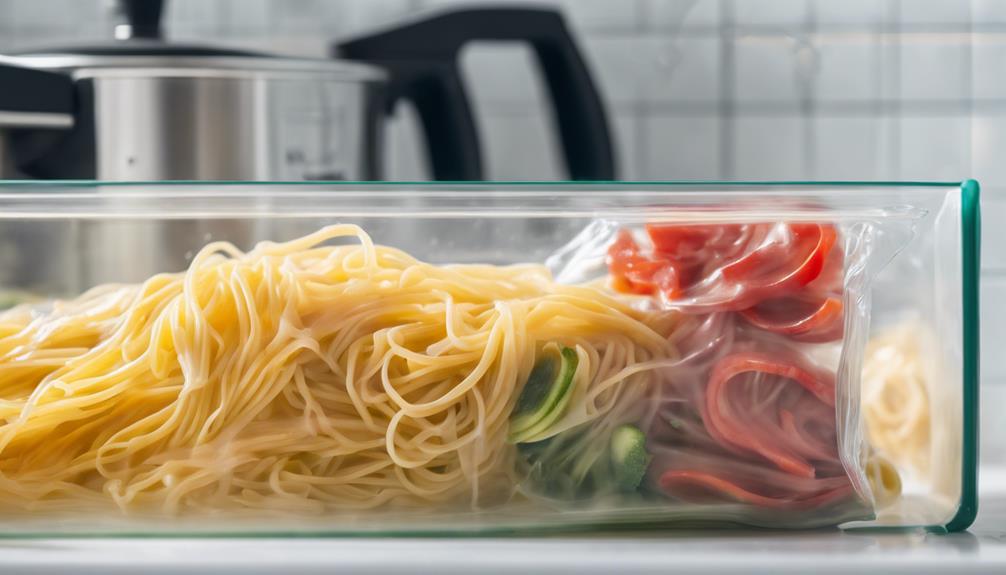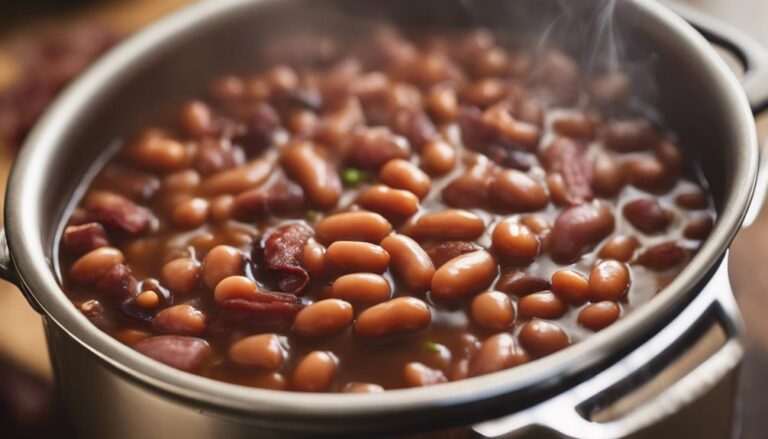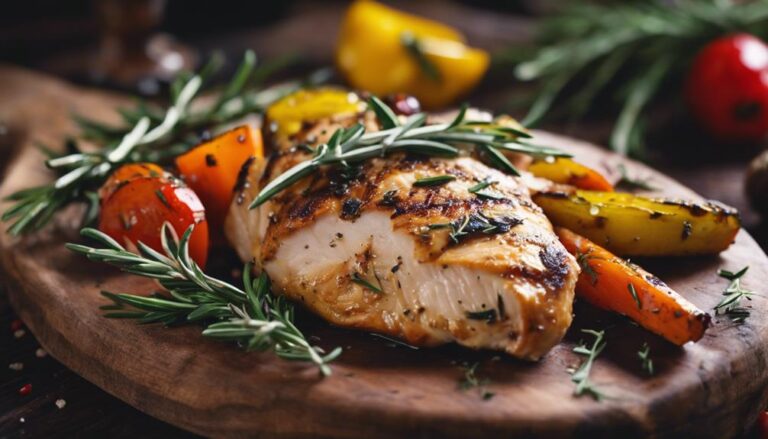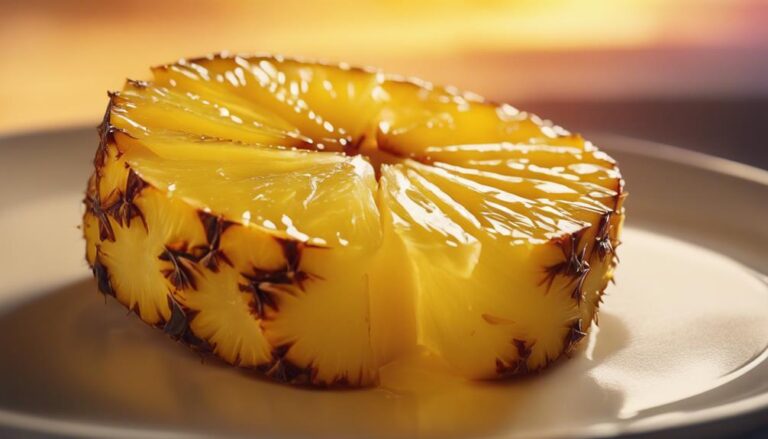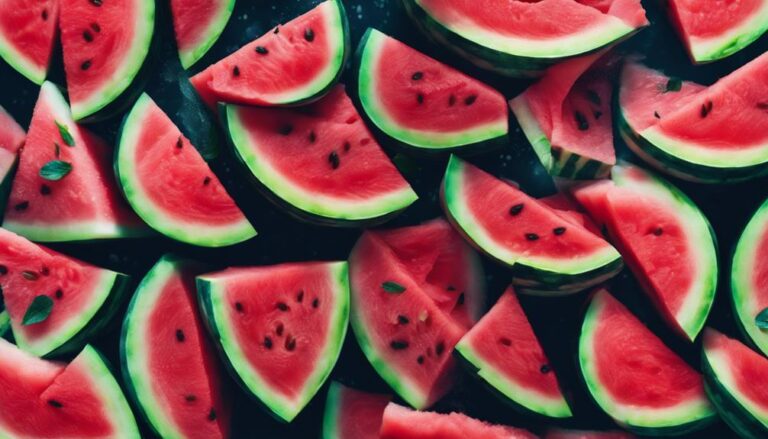Sous Vide Pasta Primavera
For a modern twist on a classic Italian dish, try sous vide pasta primavera. This recipe combines precise cooking techniques with vibrant seasonal vegetables to create a flavorful and healthy meal. Pasta originated in Italy, emphasizing fresh ingredients like durum wheat and eggs. Achieve the perfect pasta texture by cooking al dente and salting water for flavor enhancement. Enhance the flavor profile with herbs, garlic, and Parmesan cheese. Experiment with different vegetable combinations and cooking methods for a personalized experience. Elevate your dish with tantalizing variations like Summer Squash Medley or Zesty Lemon Asparagus Linguine. Optimize your culinary journey with Sous Vide Pasta Primavera.
What You Will Learn Here
- Sous vide pasta primavera retains flavors and nutrients.
- Precise temperature control ensures perfect pasta texture.
- Vegetables maintain color, crunch, and taste with sous vide.
- Infuse pasta with herbs and seasonings for enhanced flavors.
- Customize vegetable combinations for a personalized culinary experience.
Pasta's Italian Origins
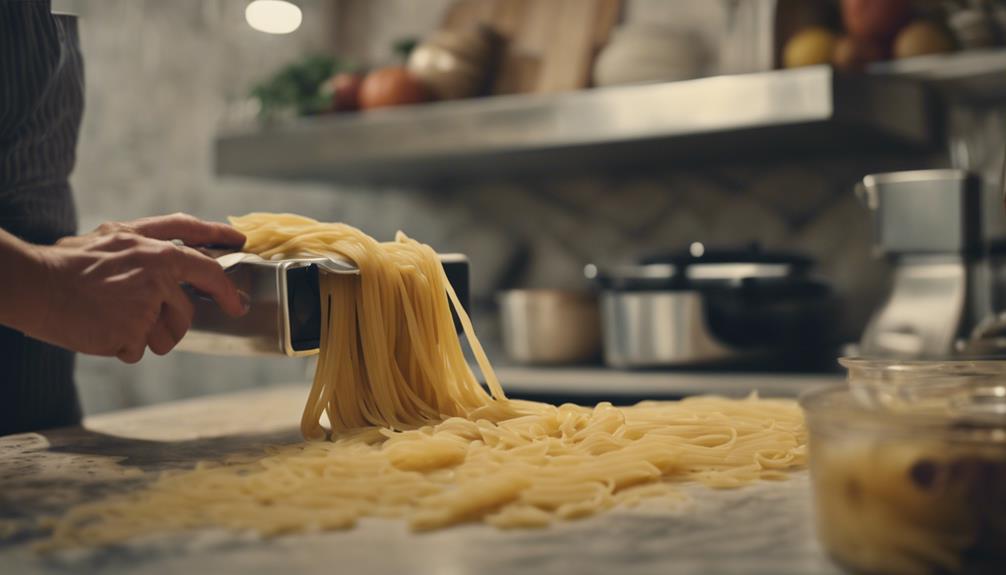
Pasta's Italian origins trace back to ancient times, showcasing Italy's rich culinary heritage.
The influence of Italian cuisine on pasta has been profound, shaping the way it's cooked and enjoyed worldwide.
Understanding the historical evolution of pasta provides insights into its cultural significance and diverse culinary adaptations.
Pasta's Italian Roots
Italian pasta dishes have a rich history deeply rooted in Mediterranean culinary traditions. Pasta, a staple of Italian cuisine, has been consumed for centuries, with its origins dating back to ancient times. The word 'pasta' itself comes from the Italian word for dough or paste, reflecting the simple yet versatile nature of this beloved food.
It is believed that pasta-making techniques were introduced to Italy by the Arabs during the Middle Ages, but pasta as it's understood today truly flourished in Italy. Different regions of Italy developed their own unique pasta shapes and recipes, contributing to the diverse array of pasta dishes available today.
Italian pasta dishes are known for their use of fresh, high-quality ingredients such as tomatoes, olive oil, garlic, and herbs. The art of cooking pasta is deeply ingrained in Italian culture, with each dish reflecting the creativity and passion of the chef. From classic spaghetti carbonara to hearty lasagna, Italian pasta dishes continue to captivate taste buds around the world.
Culinary Influence on Pasta
Culinary influences have played a significant role in shaping the evolution of pasta, particularly in its Italian origins. Pasta, originating from Italy, has been influenced by various culinary traditions over the centuries. Italian cuisine is known for its emphasis on fresh, simple ingredients that enhance the natural flavors of the dish. In the case of pasta, this means using high-quality durum wheat and fresh eggs to create the perfect dough.
The art of pasta-making has been passed down through generations, with each region in Italy having its own unique pasta shapes and recipes. From the long strands of spaghetti in Naples to the ear-shaped orecchiette in Puglia, pasta reflects the diversity of Italian culture and culinary expertise.
Italian chefs have perfected the art of pairing pasta with complementary sauces, creating iconic dishes like spaghetti carbonara, fettuccine alfredo, and lasagna. The marriage of pasta and sauce is a fundamental aspect of Italian cuisine, showcasing the harmony of flavors and textures. Whether it's a simple aglio e olio or a rich bolognese, the culinary influence on pasta has truly made it a beloved staple in Italian cuisine.
Historical Pasta Evolution
Influenced by centuries of tradition and innovation, pasta's evolution in Italy reflects a rich culinary tapestry woven from diverse cultural threads. Pasta, a staple of Italian cuisine, has a history that dates back to ancient times. The Etruscans and Greeks made a precursor to pasta by mixing flour and water to create dough. However, it was the Romans who spread this culinary art form throughout their empire.
The word 'pasta' itself has Italian origins, deriving from the Latin word 'pasta,' meaning dough or pastry. The diversity of pasta shapes and styles that we see today evolved over time, with each region in Italy contributing its own unique variations. From the long strands of spaghetti in the south to the stuffed ravioli in the north, pasta became a versatile canvas for creativity.
Italian pasta gained worldwide popularity in the 17th century when the first pasta factory was established in Naples. Since then, pasta has become a beloved dish globally, symbolizing comfort, tradition, and the rich culinary heritage of Italy.
Key Pasta Components
When preparing pasta primavera, understanding the key components of the pasta is essential for achieving the best results.
- Pasta Type: Selecting the right pasta shape is vital for pasta primavera. Choose shapes like penne, fusilli, or farfalle that can hold the sauce and vegetables well.
- Cooking Time: Cooking the pasta al dente, meaning it's firm to the bite, is important. Overcooked pasta can turn mushy and impact the overall texture of the dish.
- Salted Water: Salting the water generously before adding the pasta is a simple step that can enhance the flavor of the pasta itself. It's the only chance to season the pasta from within.
To create a delightful pasta primavera, pay attention to these key pasta components. The choice of pasta shape influences how well it holds the sauce and vegetables. Cooking the pasta just right ensures a pleasant texture, neither too hard nor too soft. Don't forget to salt the water; it's a small step that can make a big difference in enhancing the overall flavor of the dish. By mastering these key pasta components, you set the foundation for a delicious pasta primavera that will impress your taste buds.
Tasty Pasta Primavera Variations
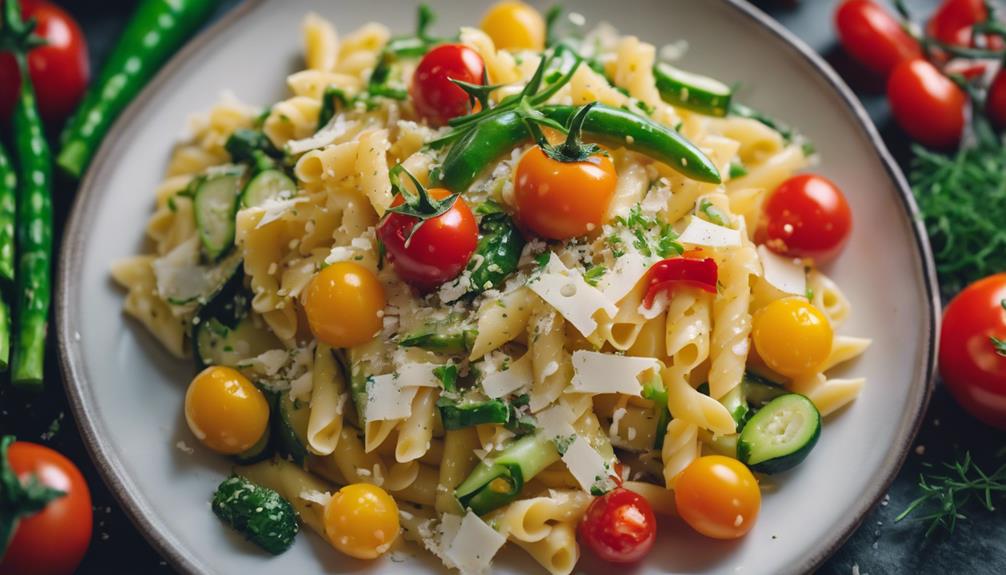
Explore a world of pasta possibilities with vibrant veggie Pasta Primavera, a delightful Summer Squash Medley Recipe, and the invigorating Zesty Lemon Asparagus Linguine. These variations offer a spectrum of flavors and textures to elevate your pasta game and tantalize your taste buds.
Whether you crave a burst of freshness, a hint of zest, or a medley of summer veggies, these Pasta Primavera variations have something for everyone.
Vibrant Veggie Pasta Primavera
For a vibrant twist on traditional Pasta Primavera, consider incorporating a variety of colorful vegetables to elevate the dish's flavors and visual appeal. Adding a burst of freshness and nutrition, these veggies can transform your Pasta Primavera into a delightful and wholesome meal.
- Bell Peppers: Slice up vibrant red, yellow, and green bell peppers to bring a sweet crunch to your pasta. These peppers not only add a pop of color but also offer a juicy texture that complements the dish perfectly.
- Cherry Tomatoes: Bursting with tangy sweetness, cherry tomatoes are a great addition to Pasta Primavera. Their small size and bright red hue add a playful element to the dish, while their flavor intensifies as they cook.
- Broccoli Florets: Broccoli florets add a mild, slightly bitter taste to the Pasta Primavera. They also provide a satisfying crunch and a boost of nutrients, making your dish both flavorful and nutritious.
Summer Squash Medley Recipe
Consider incorporating a variety of summer squash into your Pasta Primavera for a delightful twist on this classic dish. Summer squash adds a fresh and invigorating flavor to the medley, elevating the overall taste experience.
Here's how you can prepare a Summer Squash Medley to enhance your Pasta Primavera:
- Ingredients:
- Yellow squash
- Zucchini
- Cherry tomatoes
- Preparation:
- Slice the yellow squash and zucchini into thin rounds.
- Halve the cherry tomatoes for bursts of juicy flavor.
- Cooking:
- Sauté the sliced squash and zucchini in olive oil until tender.
- Add the cherry tomatoes and cook briefly to soften slightly.
Incorporating this Summer Squash Medley into your Pasta Primavera provides a colorful array of flavors and textures. The combination of the tender squash, juicy tomatoes, and al dente pasta creates a dish that's both satisfying and invigorating.
Enjoy the taste of summer in every bite!
Zesty Lemon Asparagus Linguine
Enhance your Pasta Primavera with a burst of zesty flavor by incorporating lemon-infused asparagus linguine into the mix. When preparing this delightful variation of the classic dish, follow these simple steps to elevate your culinary experience:
- Lemon Zest Infusion: Grate fresh lemon zest into your asparagus linguine for a vibrant citrus kick that brightens the dish.
- Garlic Butter Drizzle: Sauté minced garlic in butter until fragrant, then drizzle this aromatic mixture over your lemon asparagus linguine for a rich and savory finish.
- Parmesan Sprinkle: Top off your zesty creation with a generous sprinkle of grated Parmesan cheese to add a salty, nutty note that ties all the flavors together harmoniously.
Enhancing Pasta's Flavor Profile
To enhance your pasta's flavor profile, consider incorporating flavor-boosting ingredients like fresh herbs, garlic, and quality Parmesan cheese.
Experiment with different cooking techniques such as roasting vegetables for a richer taste or adding a splash of white wine for depth.
Pair your pasta with seasonal produce like cherry tomatoes in the summer or butternut squash in the fall to elevate the dish's flavors.
Flavor-Boosting Ingredients
For a more vibrant flavor profile when preparing Sous Vide Pasta Primavera, consider incorporating a variety of fresh herbs and aromatic spices into the dish. Herbs like basil, parsley, and oregano can add a burst of freshness to the pasta, while spices such as garlic powder, red pepper flakes, and black pepper can bring depth and warmth to the flavors. Don't forget about the power of citrus zest from lemons or oranges to brighten up the dish.
Additionally, ingredients like grated Parmesan cheese or pecorino Romano can contribute a savory umami flavor, enhancing the overall taste of the pasta. Toasted pine nuts or walnuts can provide a delightful crunch and nuttiness that complements the vegetables and pasta perfectly.
Experimenting with different combinations of these flavor-boosting ingredients can elevate your Sous Vide Pasta Primavera to a restaurant-quality dish that will impress your family and friends. Don't be afraid to get creative and tailor the flavors to your liking for a truly memorable dining experience.
Cooking Techniques to Try
Utilizing various cooking techniques can greatly enhance the flavor profile of your Sous Vide Pasta Primavera. One effective method to elevate the taste of your pasta dish is by toasting the dry pasta in a skillet before cooking it sous vide. This simple step adds a nutty flavor and helps the pasta hold sauce better.
Another technique is finishing the pasta in a hot skillet after cooking sous vide. This quick sear caramelizes the surface of the pasta, enhancing its texture and adding a depth of flavor.
Experimenting with different cooking liquids can also make a significant difference in the taste of your Pasta Primavera. Instead of using plain water, try cooking the pasta in a mixture of broth and white wine for added complexity. Additionally, infusing the cooking liquid with herbs or aromatics can infuse the pasta with extra flavor during the cooking process.
Seasonal Produce Pairings
Enhance the flavor profile of your Sous Vide Pasta Primavera by pairing it with seasonal produce that complements the dish perfectly. Seasonal vegetables like cherry tomatoes, zucchini, bell peppers, and asparagus can elevate the taste of your pasta, adding freshness and vibrant colors to each bite.
Cherry tomatoes burst with juicy sweetness, balancing the savory notes of the pasta and providing a burst of flavor in every forkful. Zucchini adds a mild, slightly earthy taste that complements the pasta's creaminess, while bell peppers offer a crunchy texture and a subtle sweetness that enhances the overall dish. Asparagus brings a touch of elegance with its tender spears and a slightly nutty flavor that pairs beautifully with the pasta and sauce.
Final Thoughts

In conclusion, consider experimenting with different vegetable combinations to personalize your Sous Vide Pasta Primavera experience. The beauty of this dish lies in its versatility; by mixing and matching various seasonal produce, you can create a culinary masterpiece tailored to your preferences. Whether you prefer a medley of vibrant bell peppers and zucchini or a more earthy blend of mushrooms and asparagus, the choice is yours.
Sous Vide Pasta Primavera offers a fresh and healthy twist to traditional pasta dishes. The gentle cooking method preserves the vegetables' nutrients and vibrant colors, resulting in a visually appealing and nutritious meal. By customizing the vegetable selection, you can cater to your taste buds while still enjoying a wholesome dish.
Don't be afraid to play around with different herbs and seasonings to elevate the flavors in your Sous Vide Pasta Primavera. A touch of garlic, a sprinkle of Parmesan cheese, or a drizzle of olive oil can take your dish to the next level. Remember that experimentation is key to discovering your perfect combination of ingredients.
Frequently Asked Questions
Can I Use Any Type of Pasta for Pasta Primavera?
Yes, you can use various types of pasta for pasta primavera. The best options are those with nooks and crannies to hold the sauce. Try penne, fusilli, or farfalle for a delightful pasta primavera experience.
How Can I Make Pasta Primavera Gluten-Free?
To make pasta primavera gluten-free, opt for gluten-free pasta varieties like rice or corn pasta. These alternatives offer a similar texture and taste. Make sure your sauce and other ingredients are also gluten-free to enjoy a delicious, safe meal.
Is Pasta Primavera Suitable for Vegetarians?
Yes, pasta primavera is suitable for vegetarians. The dish typically consists of pasta and a variety of fresh vegetables, making it a great option for those following a vegetarian diet. Enjoy your meatless meal!
What Are Some Creative Toppings for Pasta Primavera?
For creative toppings on Pasta Primavera, try roasted pine nuts, sun-dried tomatoes, or a sprinkle of truffle oil. Experiment with fresh herbs like basil or parsley. Don't forget a drizzle of balsamic glaze for extra flavor.
Can I Prepare Pasta Primavera in Advance and Reheat It Later?
Yes, you can prepare pasta primavera in advance and reheat it later. Store it properly to maintain freshness. When ready to eat, simply reheat the dish in the microwave or on the stovetop. Enjoy your pre-prepped meal!
Conclusion
To sum up, sous vide pasta primavera is a delicious and versatile dish that can be customized to suit your taste preferences. By cooking the pasta and vegetables in a vacuum-sealed bag, you can lock in flavors and nutrients for a perfectly cooked meal every time.
Experiment with different pasta shapes, vegetables, and seasonings to create your own unique take on this classic Italian dish. Enjoy exploring the world of sous vide cooking and elevate your pasta game with pasta primavera!
